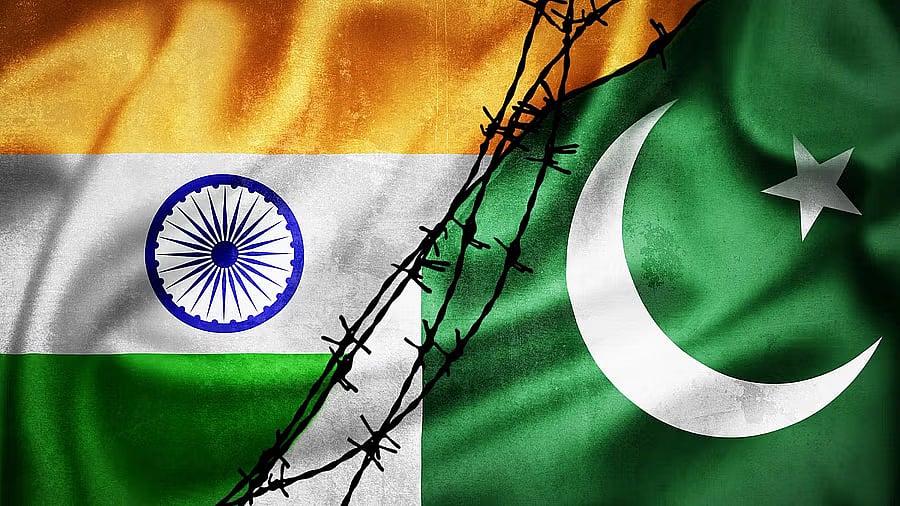
Image for representation showing flags of India and Pakistan.
Credit: iStock Photo
Speaking at the Shangri-La Dialogue in Singapore last week, India’s Chief of Defence Staff General Anil Chauhan noted that 15% of efforts during Operation Sindoor were spent quashing fake news, misleading narratives, and disinformation. Constant exposure to news is often addictive, especially for those who are not compulsively, or professionally, engaged to keep track of major developments and narratives. An interesting offshoot of the recent India-Pakistan standoff has been the craving for war
displayed by many in the form of constant calls for military
escalation, especially on
social media.
These patterns are primarily psychological and involve a complex interplay of factors. Our insights into the perceived injustice and emotionally charged sub-continental ties between the two nations often act as catalysts. The war of narratives and the information dissemination ballgame is another societal battle of attrition. To add grime, you have an information ecosystem that is marked by claims, counterclaims, and an agenda to unravel the truth. Since the Kargil conflict theatre in 1999, public engagement with India-Pakistan clashes has swelled manifold. Perhaps the macabre nature of the carnage in targeting hapless tourists heightened public engagement, often whipping
up a war craving and frenzy – this was more prominent among those who watch television debates.
Those who questioned the government’s decision to accept a ceasefire, despite the armed forces being in combat mode, may have been influenced by this war yearning. Trolls and pejoratives targeting Foreign Secretary Vikram Misri over India “squandering” its gains are also outcomes of this war craving. For influencers and social media peddlers, cessation of military hostilities might be like a plug being pulled; akin to a game abruptly stopped just as constant updates were building anticipation of something humongous on the horizon.
Here was a conflict with imagery of sirens, blackouts, and loitering munitions, presented with claims and counterclaims, compelling watchers to actively strive for and assess varying narratives. Sifting chaff from the grain is a non-starter in today’s digital information age. This seems to have affected even Congress, the principal Opposition party, prompting its President Mallikarjun Kharge to remark – “The fog of war is now clearing.”
The luxury of not knowing
The reason for the differing perceptions among the Opposition parties on Operation Sindoor may be what in psychology is termed ‘groupthink’. A group prioritises consensus over critical evaluation of alternatives, often impacting decision-making in battles, more in strategic and political contexts. Thus the longing for consensus within a cohesive group leads to suppression of dissenting viewpoints. When India and Pakistan are at daggers drawn and everyone is measuring India’s response to Islamabad’s dangerous gambit, a deluge of information, shared through multiple social media platforms, can easily foster groupthink among individuals who are engaged in digital information-sharing communities. This can even explain the argument that the government is using the success of the Armed Forces to the ruling party’s advantage.
This mystery of unknowing plays a major role in modern conflicts such as the ones involving Russia and Ukraine or Israel and Palestine. People who were hitherto disinterested in following the India-Pakistan slug-fests sought answers to their inquisitiveness, resulting in greater engagement. From an information-processing perspective, those not closely related to the conflict also had to pull the plug. The cessation of hostilities was a premature termination, like social glue drying up, for many. This would never apply to journalists who have to continue tracking the events. If this was just a border conflagration, even ghastly, like Galwan or Doklam, such attachment was unlikely. Hence in most private conversations and get-togethers, several people advocated for continuous military action and upping the escalation matrix.
When 15% of the operational time is spent countering false narratives, the situation exemplifies a conflict that is non-contact and multi-domain. Many psychologists have spoken about the theory of ‘excitation transfer’ wherein public response is a residual, emotional arousal from one event intensifying reactions to a subsequent event. As a result, a narrative of ‘the dangerous other’ is created. We had seen this to some extent during Kargil and the Uri-Pulwama attacks but a plethora of channels and social media reels has intensified this ‘excitation transfer’.
The associated perceptions of hatred augment the emotional significance of payback or retribution. The sense of national identity becomes a powerful force, influencing how individuals perceive themselves and ‘others’, consistently driving their actions during an armed conflict.
(The writer is a commentator on politics and society)